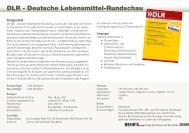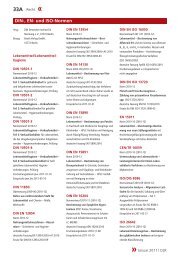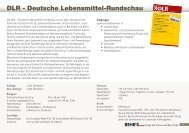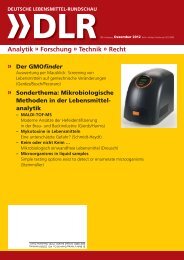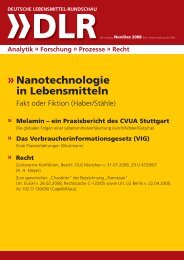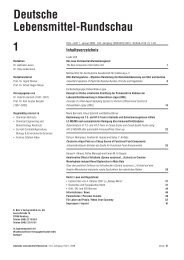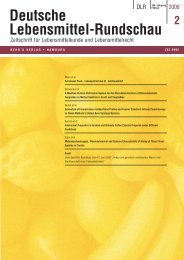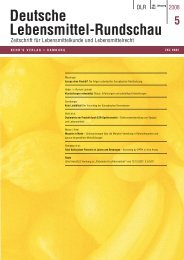Deutsche Lebensmittel-Rundschau 06/08 - DLR Online: Deutsche ...
Deutsche Lebensmittel-Rundschau 06/08 - DLR Online: Deutsche ...
Deutsche Lebensmittel-Rundschau 06/08 - DLR Online: Deutsche ...
Sie wollen auch ein ePaper? Erhöhen Sie die Reichweite Ihrer Titel.
YUMPU macht aus Druck-PDFs automatisch weboptimierte ePaper, die Google liebt.
tion reached 70 eV. The concentrations of ethyl carbamate<br />
in the examined samples were determined based on a calibration<br />
curve. The recovery of ethyl carbamate ranged between<br />
90–104 %, and detection limit was 0.01 mg/l.<br />
Statistical analysis<br />
Triplicate samples were prepared for each determination<br />
listed above. Students t-test was used to evaluate data distribution.<br />
The statistical analyses (means, standard deviation,<br />
Pearson’s coefficient of correlation (r), Student t-test,<br />
were carried out using Origin 6.0 software.<br />
Results and discussion<br />
The quantitatively significant group of fermentation byproducts<br />
represent higher alcohols. The concentration of<br />
isobutyl and isoamyl alcohols in unaged spirits ranged between<br />
1.32 g in plum spirit and 1.67 g/l alcohol 100 % (v/v)<br />
in aronia spirit. As can be seen in Table 1, the proof differences<br />
in tested spirits had no statistically significant effect<br />
on the changes in higher alcohol contents during maturation<br />
(p > 0.20). After 9 weeks of maturation, the concentration<br />
of higher alcohol increased of ca. 16–30 % in spirits<br />
aged at 20 °C, and of 29–48 % in distillates aged at 40 °C.<br />
The following results are in line with the study of Mangas<br />
et al. 12) , who explained these changes on the basis of the<br />
acid catalysed transesterification reaction resulting from the<br />
nucleophilic characteristic of the major component of the<br />
spirits, namely ethanol.<br />
The next compound of by-products of fermentation is<br />
acetaldehyde (Tab. 2), as representative of carbonyl compounds.<br />
The concentration of acetaldehyde (0.143 g/l alcohol<br />
100 % (v/v)) in unaged aronia spirit was higher than in<br />
plum spirit (0.<strong>08</strong>5 g/l alcohol 100 % (v/v)).<br />
A significant increase in acetaldehyde content was observed<br />
in all spirit samples during maturation (p < 0.001), especially<br />
at the first period of 3 weeks. After this time the sam-<br />
Tab. 1 Content changes of higher alcohols (isobutyl and isoamyl alcohol) in fruit spirits during<br />
maturation<br />
Concentration of higher alcohols [g/l alcohol 100 % (v/v)]<br />
Sample [%, v/v] 45 55 65 55<br />
Maturation time<br />
[weeks]<br />
20 °C 40°C<br />
0 1.32±0.<strong>08</strong> (P)<br />
1.67±0.11 (A)<br />
3 1.45±0.<strong>08</strong> (P)<br />
1.84±0.12 (A)<br />
6 1.62±0.10 (P)<br />
1.89±0.12 (A)<br />
9 1.72±0.12 (P)<br />
1.97±0.15 (A)<br />
P: plum sprit; A: aronia spirit<br />
1.32±0.<strong>08</strong> (P)<br />
1.67±0.11 (A)<br />
1.41±0.07 (P)<br />
1.87±0.12 (A)<br />
1.59±0.10 (P)<br />
1.81±0.10 (A)<br />
1.77±0.12 (P)<br />
1.94±0.13 (A)<br />
1.32±0.<strong>08</strong> (P)<br />
1.67±0.11 (A)<br />
1.44±0.<strong>06</strong> (P)<br />
1.82±0.12 (A)<br />
1.67±0.10 (P)<br />
1.91±0.15 (A)<br />
1.87±0.12 (P)<br />
1.98±0.15 (A)<br />
ples of matured spirits showed an increase in acetaldehyde<br />
concentrations, over 2-fold in plum spirits and of 59–74 %<br />
in aronia spirits. The results are in accordance with the effects<br />
described by Nielepkowicz-Charczuk et al. 13) .<br />
Statistical methods applied for the description of relationships<br />
between the concentration of ethyl alcohol and the<br />
content of acetaldehyde in spirits after maturation failed<br />
to demonstrate any significant correlation (plum spirits r =<br />
–0.866; aronia spirits r = –0.544).<br />
The maturation at 40 °C influenced on the changes of<br />
acetaldehyde levels in investigated spirits, particularly after<br />
3 weeks of aging. The increase of 74 % in aronia spirit and<br />
over 2-fold in plum spirit was observed.<br />
Throughout maturation, acetaldehyde is produced directly<br />
from ethanol, but it is then oxidized into acetic acid, and<br />
its interaction with ethanol resulting in the production of<br />
acetal should be taken into consideration 12) .<br />
As can be seen in Table 3, the methanol concentrations decresed<br />
(p < 0.01) in all samples, probably as a consequence<br />
of different simultaneous processes: diffusion, evaporation,<br />
oxidation to formaldehyde, esterification and acetal transformation.<br />
It is generally accepted that methanol is not a byproduct<br />
of microorganism’s fermentation, but its occurrence<br />
is due to hydrolysis of pectic substances. We initially found<br />
a higher methanol level (0.193 g/100 ml alcohol 100 % (v/<br />
v)) in plum spirits than in aronia spirit (0.115 g/100 ml alcohol<br />
100 % (v/v)). The aronia berries are rich in anthocyanides<br />
which can curb activity of pectinoesterase.<br />
The established differences in ethanol content in fruit spirits,<br />
which ranged from 45 to 65 % (v/v), had no effect on<br />
methanol level (p > 0.20) during maturation. The highest<br />
decrease of methanol content was observed in fruit spirits<br />
aged at 40° C. After 9 weeks of maturation the methanol<br />
concentrations were as follows: 0.095 g/100 ml alcohol<br />
100 % (v/v) in plum spirit, and 0.049 g/100 ml alcohol<br />
100 % (v/v) in aronia spirit.<br />
The acidity of unaged fruit spirits ranged between 0.53 g<br />
and 0.65 g acetic acid/l alcohol 100 % (v/v) (Tab. 4). After<br />
3 weeks of maturation, no statistically<br />
1.32±0.<strong>08</strong> (P)<br />
1.67±0.11 (A)<br />
1.56±0.<strong>08</strong> (P)<br />
1.89±0.15 (A)<br />
1.88±0.10 (P)<br />
1.98±0.15 (A)<br />
1.96±0.10 (P)<br />
2.15±0.17 (A)<br />
significant changes were observed in the<br />
acidity of all the spirits (p > 0.20). At the<br />
next period of aging, the content of acetic<br />
acid in investigated distillates slightly<br />
increased.<br />
The diversification in ethanol content in<br />
spirits from 45 to 65 % (v/v), had no effect<br />
on the changes of acidity levels during<br />
maturation (p > 0.10). The highest decrease<br />
in acetic acid content was observed<br />
in samples of spirits aged at 40 °C. Our<br />
results are in accordance with the ones<br />
described by Sefton 14) and Nielepkowicz-<br />
Charczuk et al. 15) .<br />
Esters of monocarboxylic acids have<br />
been regarded as compounds that exert<br />
290 ı Originalarbeiten <strong>Deutsche</strong> <strong>Lebensmittel</strong>-<strong>Rundschau</strong> ı 104. Jahrgang, Heft 6, 20<strong>08</strong>




